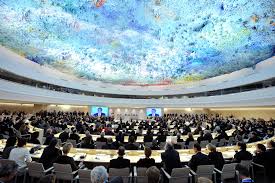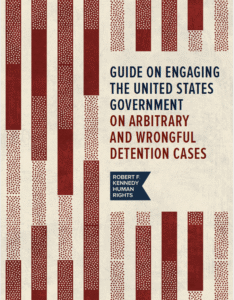This year, the U.N. Human Rights Committee adopted its long-awaited General Comment 37 on Article 21 of the International Covenant on Civil and Political Rights (ICCPR), the right to peaceful assembly. In addition to describing and further illuminating the core tenets of the right to peaceful assembly, the comment also reaches more novel and nuanced aspects, like defining peacefulness and violence in assemblies, recognizing assembly in digital spaces, and outlining best practices and responsibilities for law enforcement in policing assemblies.
The right to peaceful assembly is one of the foundational aspects of civic space—the capacity available for individuals and groups to organize, participate, and communicate with each other freely and, in doing so, to influence the political and social structures around them. RFK Human Rights works to promote and protect civic space through advocacy and strategic litigation around the rights to peaceful assembly, freedom of expression, and freedom of association.
Beginning today, RFK Human Rights will publish a blog series further highlighting some of the novel elements of General Comment 37. As the comment’s rapporteur, Professor Christof Heyns has observed, the right to peaceful assembly is of particular importance in the present moment, with protests erupting daily around the world, and because it has been the vehicle for so many of the last half century’s major social changes.
Regional Citations for A Global Concept
To locate one novel aspect of General Comment 37, bypass the main text and look instead to the footnotes. A recent Just Security post by Prof. Martin Scheinin noted that, as a general rule, the U.N. Human Rights Committee (HRC) relies primarily on its own practice, the review of periodic governmental reporting and individual complaint adjudication to develop the meaning and application of the International Covenant on Civil and Political Rights (ICCPR). Beginning with General Comment 36 on the right to life, however, the Committee started to include support from other sources, like the jurisprudence of regional human rights mechanisms and regional soft law instruments.
Citations buried in footnotes may not seem groundbreaking. Yet, these represent the HRC’s willingness to consider and engage with regional jurisprudence, standards, and trends, and that is a cause for celebration. This engagement underscores the principle of the universality of human rights, and, particularly of the right to peaceful assembly. As noted in the Inter-American Court of Human Rights’ recent publication Dialogue Between Regional Human Rights Courts, judicial dialogue among the regional human rights systems—and now incorporating the international system as well—can advance reasoning and combat fragmentation of interpretation. Similar legal issues in different regions, including risks to fundamental rights, may have common solutions and lead to coordinated responses.
Now, it is important to recognize the value of the HRC’s step towards greater engagement while simultaneously encouraging progress in the future. For example, General Comment 37 cites sources from the European, Inter-American, and African human rights systems, as well as making one mention of the Arab Charter on Human Rights. This diversity deserves appreciation, despite considerable disparity in the numbers. Perhaps unsurprisingly, more than half the regional documents cited (12 of 19) are European in origin, with the majority of those being decisions of the European Court of Human Rights. By contrast, the comment refers to one Inter-American Court judgment and none from either the African Court or Commission, though soft law sources from both regions are included. While the European jurisprudence on this issue is far more extensive than in the other regional systems—and thus an imbalance in citations is to be expected—this fact does not fully explain such a significant variance.
This disproportionate European focus was noted in an earlier version, too; Just Security’s mini-forum on the draft general comment included a comprehensive post by Prof. Evelyn Aswad identifying various risks and potential dangers of the HRC utilizing regional citations. While we understand the concerns expressed and recognize some validity, we have found interregional collaboration and the exchange of regional standards to be particularly useful and effective in some cases.
As a recent example, just a few weeks ago, the Supreme Court of Colombia condemned the violent repression of anti-government protests in November 2019, in a ruling on a tutela* (a constitutional injunction), which sought to challenge the actions of the security forces and uphold constitutional rights of peaceful protest, freedom of expression, and protection of the press. Media Defence and RFK Human Rights had submitted an amicus curiae brief in the case, focusing on the international legal standards concerning the protection of journalists reporting on protests. In holding that Colombia’s security forces had engaged in consistent acts of aggression, the Supreme Court underlined the constitutional and international legal guarantees regarding the use of force by law enforcement during demonstrations.
Our belief in useful cross-regional commonalities is a main driver of RFK Human Rights’ work to promote interregional collaboration on strategic litigation for the protection of civic space. Sharing arguments and interpretations across regions has the potential to extend the impact of civic space-protecting case law beyond its source region. The opportunity to turn these efforts toward the HRC is not one to be ignored.
RFK Human Rights—and civil society more generally—can now act on the opening presented by General Comment 37’s regional citations and work to increase the Committee’s exposure to and appreciation for regional jurisprudence. Hopefully, General Comment 37 is truly emblematic of an interest in increased dialogue among the regional and international human rights mechanisms and will serve as encouragement for litigants and activists to look beyond their own regions for guidance and support in the work of protecting the right to peaceful assembly and all fundamental human rights.




